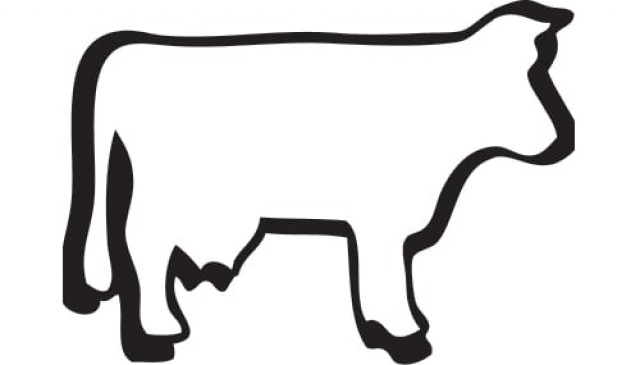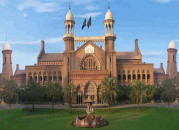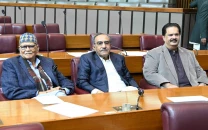The black cows of the white revolution

Unfortunately, Nana’s vegetable-growing prowess didn’t translate into livestock farming success. The cows didn’t produce enough milk and when Nana’s brother was getting married, one cow had to be sold.
Then one day fate brought him to Dr Aziz Ahmed at the Pakistan Dairy Development Company (PDCC). “Dr Aziz told me to untie my animal so that it had access to food and water as many times as it wanted in a day,” Nana told The Express Tribune. He also learnt how to fence his land using twigs so that the unleashed cow wouldn’t stray.
Nana also learned how to cut down his costs by growing his own fodder. At one corner of his little field, he grows mud grass which farmers call haathi ghans (elephant grass) because of its ability to endure hard weather. It grows all year round and has a healthy six per cent protein content.
For one year, Nana worked with the experts at the Pakistan dairy and today he not only has three cows and one bull but each cow yields Rs350 every day. The experience has turned Nana’s life around and given his family of five security. A confident Nana now has plans to sell the bull and buy a pregnant cow.
The PDDC was set up in 2005 and is currently being funded primarily by the government and partly by the private sector. Under its Doodh Darya scheme, it provides free advisory services to farmers in the dairy sector. The idea is to empower them by giving them proper advice and medical help.
One thing the company does not do is help farmers with cash or animals. “It is human nature to take free things for granted,” said Mohammad Jan, a PDDC farm production advisor, while explaining the reasoning behind the goal to teach farmers how to profit from their own resources.
What sets Doodh Darya apart from previous dairy schemes is the door-to-door service to the farmer. Instead of calling farmers to training sessions, officials go to each farmer separately and cater to their specific needs. “The farmer is a busy man, he has no time to spare,” explained PDDC vet Dr Aziz Ahmed. “That is why we go to them, even if they call us for help at two in the morning.”
Much of the Pakistan Dairy techniques are grounded in common sense. They convince farmers that cattle should be reared in its natural environment and artificial methods should be avoided.
“Pharmaceuticals and feeding companies have destroyed the dairy sector,” Ahmed complained.
Due to a lack of labour, many farmers have started using a hormone called oxytocin to milk more out of cows. Giving a shot of this steroid relaxes the muscles in the cow’s udder, allowing the milk to pour out. However, traces of these steroids may find their way into the milk and cause hormonal imbalances in human beings.
“While in developed countries these drugs have been banned, in Pakistan an amount as much as 50 cubic centimetres (cc) is available for Rs12,” said Jan.
Qadeer Ahmed is a farm manager who was using 6cc of oxytocin a day for each of his 50 cows. Once his cows stopped breeding, Qadeer lost all hope and was ready to shut down business. When the Pakistan Dairy approached him, they told him to cut down the oxytocin shot gradually. Today, Qadeer is the proud manager of 150 animals.
Pakistan Dairy encourages the use of milking machines that give gentle vibrations to the udder and simulate muscles so that the milk comes out. But milking machines require electricity and that is a scarce resource in rural areas.
An alternative to this is bio gas. According to Dr Ahmed, dung from 10 cows can be used to run a 15 kilovolt generator. Another practice that the organisation tries to dissuade is the use of hay as it is less nutritious than silage (wet grass). Even though silage is cheaper at Rs2 per kilogramme (kg), farmers are tradition-bound to hay that costs Rs5 per kg. “We ask the farmer to stock silage when it is cheapest and preserve it,” Dr Ahmed recommended.
Pakistan Dairy has established over 800 model farms all across the country to serve an example for the farming community. The animals here are left untied, water showers are installed to prevent heat stress, each animal is tagged with a number and separated into various compartments according to its state, such as pregnancy, dry period or milking.
The successes of the scheme, have, however, been hard won at a time when government aid is drying up. Changing the farmer mindsets is a cumbersome task and many times all scientific reasoning is tossed aside when farmers refuse to listen because their ancestors used to tie up the animals. Cases such as Nana’s, however, are slowly making waves in the Doodh Darya.
Reporting by Sidrah Roghay
Published in The Express Tribune, July 22nd, 2010.



















COMMENTS
Comments are moderated and generally will be posted if they are on-topic and not abusive.
For more information, please see our Comments FAQ